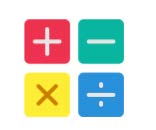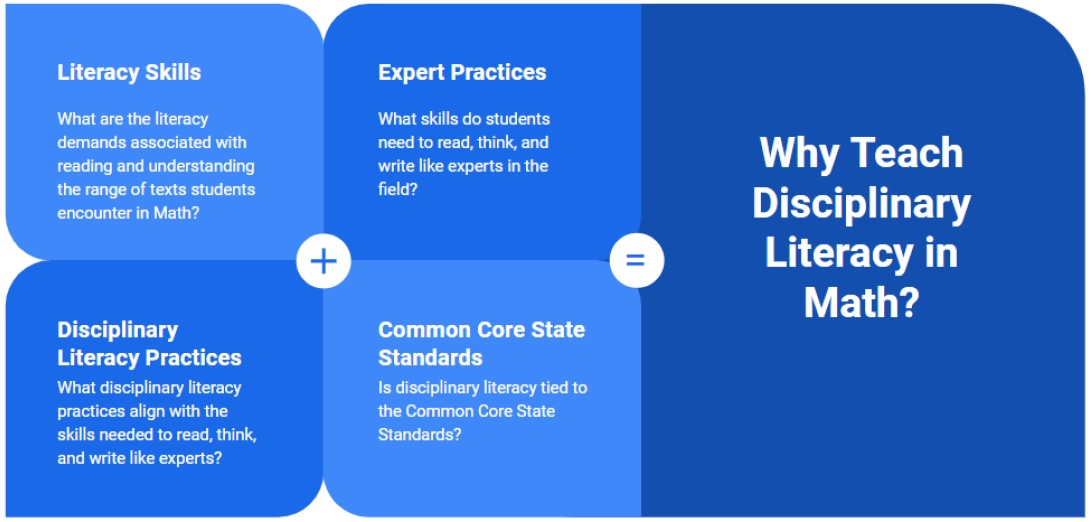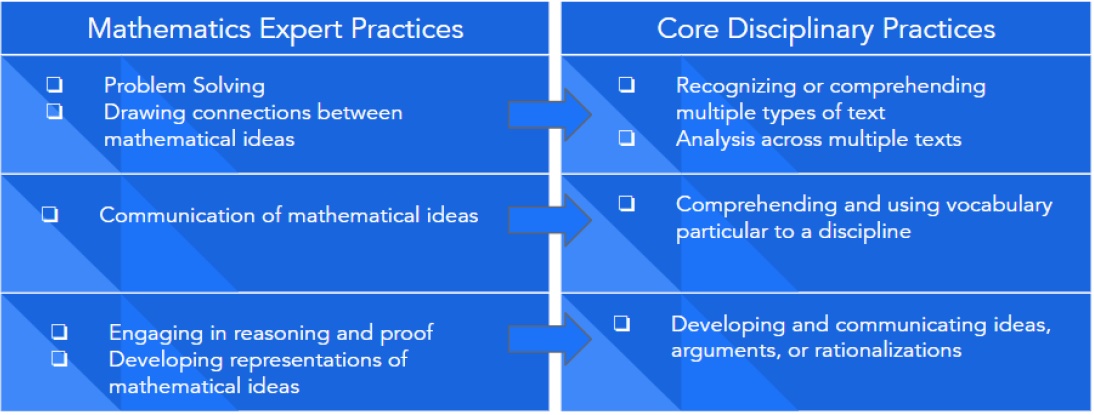Why is it Important to Teach Disciplinary Literacy in Math?

When we think about literacy instruction, many of us may envision teaching reading and writing skills within Language Arts only. It may even be hard to picture ourselves teaching reading skills within the math classroom. Specifically, we might have the mindset that literacy instruction does not belong within the math classroom or that you just don’t have the time to teach students how to read when you have to teach them how to do math! This begs the question, “why is it important to teach literacy skills in math?”
One way to reflect and broaden our thinking is to ask ourselves: What are the literacy demands associated with reading and understanding the range of texts students are likely to encounter in the math classroom? Once we have identified these demands, it will likely shed some light on the broad range of literacy skills students need to demonstrate their understanding of math concepts. From there, we can explore how to incorporate these literacy practices into our math instruction, relating them to the skills used by experts in the field and aligning them with Common Core State Standards.

Areas that support teaching disciplinary literacy in math (Colwell, Hutchison, & Woodward, 2020)
What are the literacy demands associated with reading and understanding the range of texts students are likely to encounter in the math classroom?
Considering the demands placed on students to read and understand the different ways math problems are represented can help shape your understanding of why teaching literacy within math is important to overall student progress. These demands might include:
- reading and making sense of written directions,
- interpreting information represented in charts, tables, and graphs,
- reading and understanding math vocabulary and using it to communicate thinking,
- reading and interpreting word problems and demonstrating understanding by drawing on a range of strategies to analyze and solve,
- reading and interpreting equations,
- and knowledge of symbols used to represent information.
While this is not an exhaustive list, we can begin to comprehend the broad range of literacy skills students need before they can even begin to solve the math. It also underscores why literacy instruction in math is so important. Can you think of any other reading skills students might need that are specific to the grade level you teach?
What skills do students need to read, think, and write like experts in this field?
With a broader view of the literacy needs specific to math, we can now explore how they relate to the skills used by experts in the field. What skills do students need to read, think, and write like math experts? The list below reflects the practices outlined by the National Council of Teachers of Mathematics (2013) that align with those used by math experts in the field. They underscore the skills required to read and comprehend the range of texts mathematicians encounter in the classroom and their professions.
- Problem solving
- Drawing connections between mathematical ideas
- Communication of mathematical ideas
- Engaging in reasoning and proof
- Developing representations of mathematical ideas.
What disciplinary literacy practices align with these demands?
Disciplinary literacy instruction occurs when students engage in math by actively reading, comprehending, and engaging with problems, both numerical and word-based, develop solutions, and communicate these solutions using mathematical language (Lent, 2017). To support lesson planning that promotes the inclusion of these skills, Colwell, Hutchinson, & Woodward (2020) developed four core disciplinary practices for the elementary grades. The following table breaks down these practices and ties them to those used by experts in the field.

Connections between Expert and Core Mathematics Practice (Colwell, Hutchison, & Woodward, 2020)
Is disciplinary literacy tied to the Common Core State Standards?
According to the Common Core State Standards Initiative (2019) “the knowledge and skills students need to be prepared for mathematics in college, career, and life are woven throughout the mathematics standards” (as cited in Colwell, Hutchinson, & Woodward, 2020). Therefore, if disciplinary literacy is defined as the specialized ways of reading and thinking used by experts in their discipline (e.g. math) and is grounded in how experts approach and use texts within their fields, it would follow that there is an inextricable connection between the Common Core State Standards (CCSS) and teaching disciplinary literacy within each content area (Colwell, Hutchison, & Woodward, 2020).
How can I incorporate disciplinary literacy practices into my math classroom to prepare students for middle school and beyond?
Now that we have a broader understanding of the literacy demands associated with reading and understand the range of texts students are likely to encounter in the math classroom, we can think about ways to incorporate disciplinary literacy practices in the math classroom. These include a consideration of state standards, identifying appropriate disciplinary literacy practices, selecting and considering multiple text types, selecting and including digital tools to support learning and making the concept accessible to all learners, and teaching vocabulary specific to the discipline.
Consider state standards when planning your lesson:
- What standards promote disciplinary literacy in mathematics? Refer to the Common Core State Standards for Mathematics and find standards that require use of language, such as "Analyze and compare two- and three-dimensional shapes, in different sizes and orientations, using informal language to describe their similarities, differences, parts..., and other attributes."
Identify appropriate disciplinary literacy practices:
- Ask, what core disciplinary practice is supported by those standards and objectives?
- How do I prepare my students to learn this topic?
- How do I guide my student’s comprehension of this topic?
- How will I differentiate instruction?
- Have I considered cultural understandings to inform this lesson?
Select and consider multiple text types:
- What text is required by my school or district?
- Which texts align with my student’s reading skills?
- What digital and multimodal texts might supplement/extend my current text? (e.g., Charts, tables, graphs, etc.)
- How do these texts give access to my ELL and Special Education students?
Select and include digital tools to support learning and make the concept accessible to all learners:
- How can I incorporate digital tools to assess students' understanding of the text?
- How can I use digital tools to assess student learning?
Teach and use math vocabulary:
- Teach students to communicate using mathematical language, explain their reasoning, and discuss problems. Mathematically Speaking is a resource teachers can use to promote mathematics discourse and promote the use of vocabulary when communicating.
- According to Colwell, Hutchinson, & Woodward (2020), “A key element of disciplinary literacy in mathematics is being able to accurately use and understand math-related vocabulary (p. 73). Vocabulary words relevant to elementary math practices can be found in the Glossary of the Mathematics CCSS.
More to Explore
Additional resources for teaching disciplinary literacy in Mathematics:
- Teachers who are interested in purchasing the book, Digitally Supported Disciplinary Literacy for Diverse K-5 Classrooms can access a review and overview of the book prior to purchasing here: http://jolle.coe.uga.edu/wp-content/uploads/2022/05/ ScottAlbert_JoLLE2022ABR_final.pdf.
- Teachers can access more information on reading and writing in the discipline by accessing the Annenberg Learner website for professional development videos and other resources you can use to learn more about disciplinary literacy in all content areas.
- This chart lists each of the major content areas as starting points for teachers to think in terms of disciplinary literacy (Lent, 2016).
References
Annenberg Learner. (2015). Reading and Writing in the Disciplines. Reading in Mathematics. [Online course]. WBH Educational Foundation. https://www.learner.org/series/reading-writing-in-the-disciplines/
Colwell, J., Hutchison, A., & Woodward, L. (2020). Digitally Supported Disciplinary Literacy for Diverse K-5 Classrooms. Teachers College Press: New York, NY.
Lent, R. (2017). Disciplinary literacy: A shift that makes sense. ASCD Express. 12(12). https://www.ascd.org/el/articles/disciplinary-literacy-a-shift-that-makes-sense
Author Note
Jane Viojan is a special education teacher at Clemens Crossing Elementary School and currently working towards a master's in teaching literacy to culturally and linguistically diverse populations at Loyola University Maryland. Click to find out more information about the Literacy Program at Loyola University Maryland.
Published: November 21, 2022